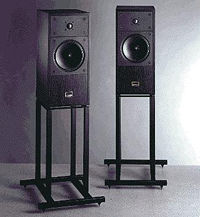Mordaunt Short, founded in Fulham in 1967, quickly established itself as a genuinely middle-class loudspeaker brand, catering to those seeking high performance in a conservatively fashioned package. For example, the 1977 Pageant was a symbol of suburban respectability, a type of hi-fi Volvo. However, the brand underwent a series of transformations, including ownership changes and market positioning. By the early 1990s, it was part of the TGI group, alongside Epos, Tannoy, and Goodmans, and it was earning accolades for its low-cost budget boxes, which were nothing like the designs it had been selling a decade before. The company was then taken by by Audio Partnership in 1999, who redesigned it for the current world…
The Performance 6 is the company’s flagship, and it cost £3,500 when it was initially released in 2010. The final pre-production version was reputedly tuned by Marantz’s Ken Ishiwata – the brand was distributed by Marantz outside the UK at the time. Designed by talented acoustician Graham Foy, the final pre-production version was reputedly tuned by Marantz’s Ken Ishiwata – the brand was distributed by Marantz outside the UK at the time. In Ishiwata’s listening room at the Marantz headquarters in Eindhoven, Holland, a pair is still in frequent use.
It appeared to be up to date at the time of its release. Its tapering, curving cabinets (1,150x240x430mm) are starting to appear a little antiquated now (speakers always seem to age aesthetically faster than any other hi-fi component), but the shape was designed to break up standing waves, so form followed function. Instead of veneered MDF, the cabinet is composed of ‘structure foam,’ which is strong yet has great interior dampening, according to Mordaunt Short. Foam of various thicknesses and densities is employed, with the most firm section running down the back spine.
The four drive units are installed from the back, with rubber gaskets sealing and isolating the drivers from the front baffle. The enclosure is light, so it doesn’t retain energy, but it does require a 10kg cast iron base for stability, bringing the total weight to 33kg. With diecast aluminium chassis and unique magnets and voice coils, Monitor Audio’s ribbed, aluminium Continuous Profile Cones are used. Underneath the 100mm midrange driver with its small, rare earth, stacked double magnets are two 165mm bass units. A system of pipes running behind the rubber-coated ATT aluminium domed tweeter, calibrated to a variety of frequencies, is believed to provide a clean and transparent sound, as well as an even load with respect to frequency. A sensitivity figure of 89db/1w/1m was mentioned, which is acceptable but not exceptional for 2010. The frequency response is reported to be 34-30,000Hz, with a power handling range of 15 to 250W.
Back in 2010, I recall being fairly taken aback by the sound of this speaker. It’s incredibly clean, crisp, and speedy, and it’s extremely well integrated and imaging-wise. It has a little less bass than its size suggests, but what it does have blends flawlessly into the midband and is also rather tuneful. It will warn you if the source you’re utilizing, or even the recording itself, is in any way deficient, but if you’ve got these right, you’ll adore its expansive, widescreen feel and explicit detailing. It reminds me of Vivid and Raidho speakers in this regard, both of which use metal drive units and are significantly more expensive. Treble is, without a doubt, quite revealing. It’s crisp, well-lit, and acute, and it’s great with good records but not so much with terrible ones.
Overall, this loudspeaker is powerful and musical, with excellent imaging and a large soundstage that reminds me more of an electrostatic than a box loudspeaker. It is, after all, a highly neutral and revealing product that necessitates substantial ancillaries. The main issue with the Mordaunt Short Performance 6 is that its ability exceeds the brand’s expectations, as I stated at the time of its launch. It may have had gold-plated British respectability back in the 1970s, but the company’s constant sequence of image and ownership changes since then have diminished its attractiveness. Then buy for sound quality rather than snob value!







